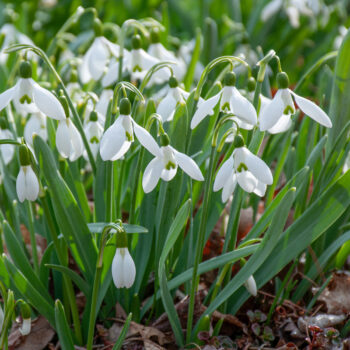Blue Squill
Scilla siberica
Specifications
Blue squill is excellent for naturalizing below deciduous trees, where it will form drifts of singing blue bells in early spring. Needs a few years to really hit its stride. Capable of self-sowing. Try it with early daffodils such as Tête-à-Tête.
Deer Resistant
Note: Blue squill is resistant to deer, but rodents such as voles and gophers may eat the bulbs.
| Item # | 6009 |
| Height | 5—7 inches |
| Sunlight | Full or Part |
| Soil | Well drained |
| Flower Color | Blue |
| Bulb Size |
7-8cm ?
Bulb size is determined by the circumference around the largest part of the bulb. Colorblends only delivers top size bulbs. Large bulbs produce more or larger flowers than small bulbs.
|
| USDA Zones |
3a—8b ?
Hardy in USDA zones 3a to 8b in the South or 9b on the West Coast. Prechill in zones 7b and warmer in the South, Southwest, and California.
|
| Bloom Time | Early |
- early
- mid
- late
Delivery & Planting Times

Spring-flowering bulbs must be planted in the fall. They need cool soil to make roots before the onset of winter. Cool fall weather arrives at different times from north to south and from high elevations to low.
Please note that the temperature of the soil lags behind the air temperature. You can generally plant later than the windows provided in this map. As long as the ground is not frozen, you can still plant.
Blue Squill
Scilla siberica
Blue squill is excellent for naturalizing below deciduous trees, where it will form drifts of singing blue bells in early spring. Needs a few years to really hit its stride. Capable of self-sowing. Try it with early daffodils such as Tête-à-Tête.
Deer Resistant
Note: Blue squill is resistant to deer, but rodents such as voles and gophers may eat the bulbs.
| Item # | 6009 |
| Height | 5—7 inches |
| Sunlight | Full or Part |
| Soil | Well drained |
| Flower Color | Blue |
| Bulb Size |
7-8cm ?
Bulb size is determined by the circumference around the largest part of the bulb. Colorblends only delivers top size bulbs. Large bulbs produce more or larger flowers than small bulbs.
|
| USDA Zones |
3a—8b ?
Hardy in USDA zones 3a to 8b in the South or 9b on the West Coast. Prechill in zones 7b and warmer in the South, Southwest, and California.
|
| Bloom Time | Early |
- early
- mid
- late
Bulb Calculator
To find the number of bulbs you need, enter the square footage of the planting area in the box below.
Area
In Sq. Ft.
Density
Bulbs/
sq. ft.
Bulbs Needed
When to Plant

Spring-flowering bulbs must be planted in the fall. They need cool soil to make roots before the onset of winter. Cool fall weather arrives at different times from north to south and from high elevations to low.
Please note that the temperature of the soil lags behind the air temperature. You can generally plant later than the windows provided in this map. As long as the ground is not frozen, you can still plant.
Planting Instructions
Full sun or partial shade. Well-drained soil. Blue squill can self-sow with abandon: If left undisturbed, a handful of bulbs may eventually become a brilliant blue carpet in spring. Can be naturalized in a lawn if you’re willing to hold off on mowing until the seed capsules open and the foliage has yellowed.
| Depth of Planting Hole | 3 inches |
| Spacing | 2 inches apart |
Planting Instructions
Full sun or partial shade. Well-drained soil. Blue squill can self-sow with abandon: If left undisturbed, a handful of bulbs may eventually become a brilliant blue carpet in spring. Can be naturalized in a lawn if you’re willing to hold off on mowing until the seed capsules open and the foliage has yellowed.
| Depth of Planting Hole | 3 inches |
| Spacing | 2 inches apart |











